Thank you for visiting SotAwiki, a Shroud of the Avatar Wiki Encyclopedia. If you see any information that is outdated, please take the time to update it, or if you prefer, leave a message for other editors. This community wiki is for the benefit of all Avatars!
Oracle Temple
Jump to navigation
Jump to search
 |
This article is currently under construction. You are welcome to help in its construction by editing it as well. |
| Location: | Central Brittany
|
The Oracle Temple can be found in Central Brittany, and is visited as part of The Path of the Oracle portion of the main quest. Within, an Avatar might have a private meeting with the Oracle.
NPCs[edit]
Conversation[edit]
| ExpandKeyword Spoiler |
|---|
Trivia[edit]
- [From a Dev+ Forum Post by Michael “Hutch” Hutchison]
'SPOILER ALERT! This post contains spoilers for the Oracle Temple scene that is the story climax of Episode 1…
With R47, we have finished the art requirements for the climactic Oracle Temple scene! When I stopped to consider the long road leading up to this point, I was struck by how this scene, perhaps more than any other single scene in the game, involved contributions from nearly every member of the Shroud team, either directly or indirectly. It is also a great example of how our iterative process worked to build one thing upon another.
Like anything else it all started with an idea. In this case, it was Richard’s initial idea that was the creative spark, and what followed was a process of evolution over years, as ideas changed, and grew, and became fully formed. Development of the objects, characters, and story followed a sequence of connected tasks, each one informing the next. Over time, it was this deliberate process that built all the smaller parts that contributed to the cohesive whole.
The importance of the Oracle becomes evident from the very first moments of the game, when you meet her in the Confirmatory on the Isle of Storms. That’s part of what makes the Oracle so special – she is there when you start the game, is present throughout your progress, and is there when you ultimately reach the story climax. But long before the Confirmatory was included on the Isle of Storms map in Release 31, the Oracle had already undergone several iterations.
Early Development
Everything started, of course, with Lord British himself. During the initial development of what became Shroud of the Avatar, Richard worked directly with concept artists (beginning very early with Scott Jones and then a bit later with Stephen Daniele) to develop the look of the Oracle architecture, her Watchers, and the Oracle herself.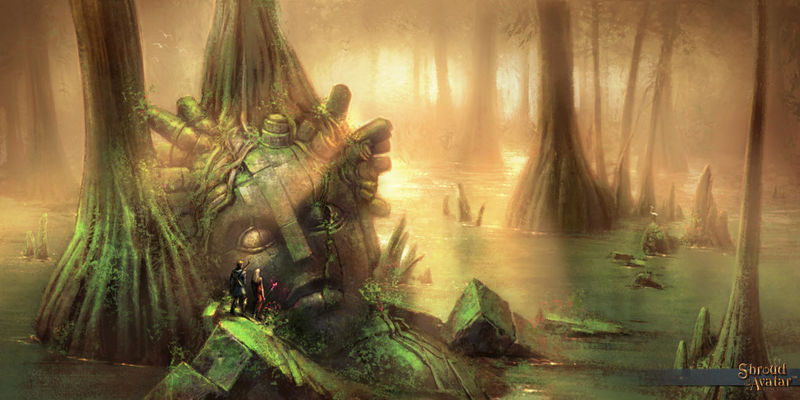
Early Oracle design as seen in concept art…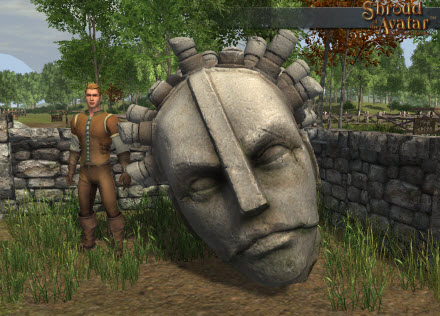
…and with the 2013 statue head decoration
While the initial glimpse of the Oracle came in December of 2013 with the Oracle Statue Head (made by former team member Jay Reichman), it would prove to be merely a teaser of what was to come…
The next items that we made from this family of assets came online as early as Release 3, in February 2104: the Oracle Watchers! These small mechanical agents act as the eyes of the Oracle, watching what happens around them throughout New Britannia and reporting it back. They were based on concept art by Stephen Daniele and created by character artists Isaac Oster and Kevin Wells, who made the “spider” and the “fly,” respectively.
Oracle Watcher concept art by Stephen Daniele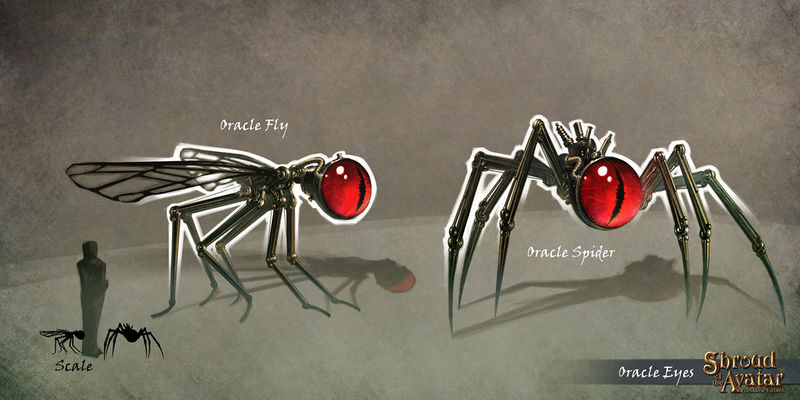
The first Watcher, made by Isaac Oster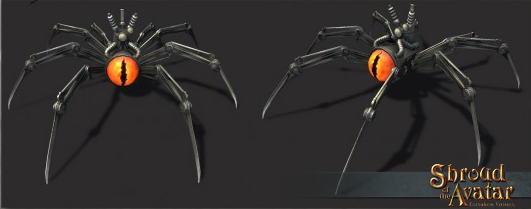
Both Watcher models were created in February 2014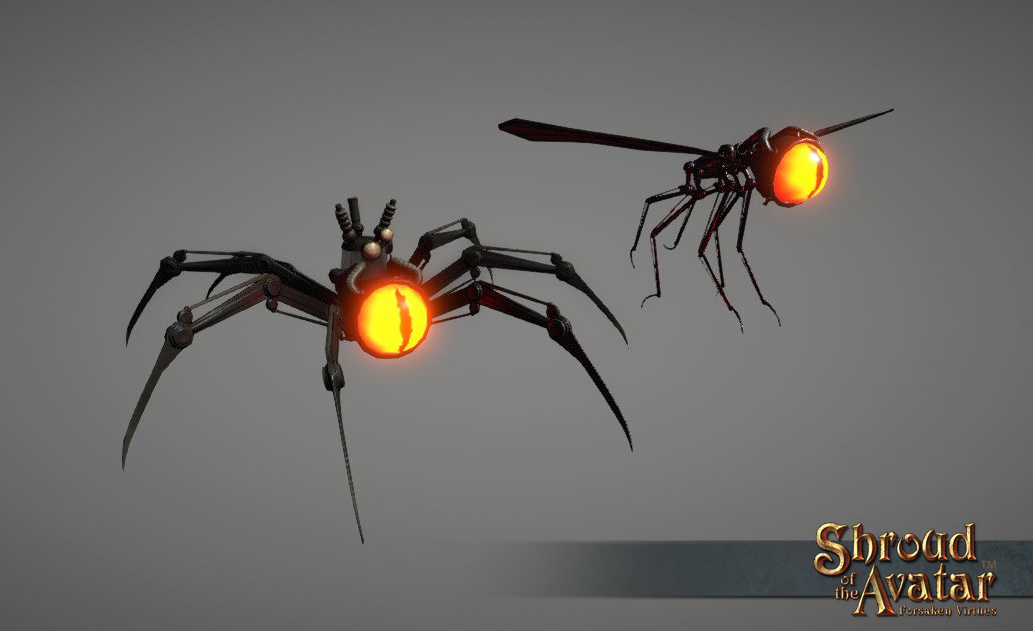
The Watchers were brought to life in the game by animator Bren Wilson and AI programmer Erik Touve. These small creatures became part of the aesthetic foundation upon which other Oracle assets would be made, and became some of the first real indicators of something different and unique in our world.
With Release 8 in July of 2014, Bob Cooksey and I began work on the first of our Oracle buildings, the Oracle Confirmatory. It was based on concept art by Stephen Daniele and was imagined as an intimate, confessional type of building. At the time, it was referred to as the “Oracle Affirmation Shrine.” A couple of months later, Release 10 saw the inclusion of VFX on its watching eyes, added by Finn Staber.
The original concept art of the Oracle Confirmatory
File:SotA oracle shrine exterior.jpg
File:SotA oracle shrine interior.jpg
The in-game model as first created in 2014
File:06a confirmatory.jpg
The Confirmatory in Ardoris
File:06a ArdorisConfirmatory.jpg
The confirmatory showed up first in Ardoris, and stands there still.
The Introduction of the Oracle
SotA’s original interactive oracle was a “pin plate” screen, envisioned as a mechanical construct that would present the face of the Oracle by using an array of primitive pegs that would extend and retract with her motions. This iteration was added to the small Confirmatory buildings with Release10 in September of 2014.
The earliest version of the Confirmatory Oracle, September 2014
After some time, we decided that this version was not engaging enough. It felt too impersonal, and didn’t succeed at creating a feeling of unease in the viewer, nor elicit any kind of emotion at all. So we began to reconsider our approach due to this sense, but also for practical reasons – the pin plate proved to be far too restrictive for animation, and the process would also be very time consuming, and probably still wouldn’t hit the mark. But the scale of the face felt right… so with Release 32 in June 2016, we changed the idea to an automaton face, taking cues from the “Wizard of Oz,” particularly the version from the stage play “Wicked.” As there are also shades of George Orwell’s “Big Brother” in SOTA’s omniscient Oracle, our design aimed to make her not only an intimidating presence, but also a somewhat creepy one. In addition, showing the Confirmatory Oracle as an automaton would mirror how she was to be presented inside the Temple itself, and so the connection would be unmistakable. Once settled, we still knew that the version inside the temple had to be really special and unique.
A very early concept of the Oracle, by Scott Jones
The Wizard as seen in “Wicked”
Much of the early inspiration for the Oracle clearly came from the “Maschinenmensch” (German for “machine-human”) from Fritz Lang’s seminal 1927 film “Metropolis.”
Maria, from “Metropolis” (1927)
The original concept art for the Oracle
To expedite production, I bought a full body model that resembled the metropolis robot, and I proceeded to make some revisions to make it more closely match our concept art, particularly in areas of the head and face. I also made sure to match the body proportions to our established animation rig, so that there would be one less thing to worry about when it came time to animate.
A work in progress shot of our first Oracle model
Once that was complete, the “head only” version was used for the Confirmatory Oracle, while we would reserve the full-body version for the climactic encounter inside the Oracle Temple in Brittany. The Confirmatory Oracle was brought to life this time by animator Matt Schmitz, who made her idling, watching, hitching, and talking.
The Oracle Temple Building
In early 2015, Bob Cooksey had made the model for the larger Oracle Temple building (once again based on a concept by Stephen Daniele), but we didn’t yet have a need to be able to access the interior, as the story climax was not yet being developed. We determined that the Temple would be its own private scene, so I revisited the Temple building model a year later to include additional details to both the exterior and interior of the structure, including the intricate metalwork adorning the interior walls. Once again I was happy to have such great concept art to refer to.
Oracle Temple exterior concept, and interior details
I put in some preliminary lighting and mist effects for atmosphere, but at this point the Temple was still just an empty stage, and it existed like this for quite a long time while we worked on the more immediate needs of the game. It wasn’t until another year later, in May of 2017, when we finally made the actual scene for the interior of the Temple.
At that time, plot lines had evolved to where we needed to finally make the end game encounter so that Scott Jennings could deliver on the goal of implementing “stage 1” of the story finale, which meant being able to complete the Truth, Love, and Courage storylines. At this stage, art and design production kicked into high gear.
I assigned Fletcher Kinnear to finish the Oracle character model, which included her throne and the tangle of cables enveloping her. He also designed the rigging in the room above her, with the only guidance given to him being to make it fit the established aesthetic, make it tailored to the room, and make it cool! He really nailed it! With these items in place, implementation of the finale became unblocked, and stage 1 was delivered in Release 42. But it was still not finished…
The Oracle model and additional room props were made during Release 42
Finish Work
Finally, with Release 47, nearly four years after the first Oracle asset was made, it came time to do the finish work!
Once again I enlisted Fletcher to create the model for monitors so that the style would be consistent with the other things he had completed for the room. I provided rough proxy models and gave him some art direction parameters to follow, and then he created the 3D models while keeping in consultation with Matt Schmitz about requirements for animation.
The detail concept for the monitors found inside the Oracle Temple
Concept art showing the various elements of the Oracle Temple assembled together
Once the base model was complete, Matt rigged and animated it, including the arm lever movements, extendable screens, and other great details like clockwork gear action.
As soon as the animations were complete, it was time for VFX artist Damon Waldrip to create all the visual effects needed for the screens and lever arms. At a high level, I wanted the displays to not only be dynamic, but I also wanted to ensure that they showed recognizable locations that would chronicle the long journey across New Britannia that lead the player to this climactic location. We focused firstly on scenes where Watchers and Confirmatories were found. I came up with a list of about 30 scenes, and Damon made 64 carefully chosen and artfully composed screenshots, based on the idea that these were video feeds from Watchers. He then used those surveillance images to make the VFX for the monitor screens.
In our concept art, the Oracle feels like a very old entity, surviving across ages, and so I wanted make sure that the screen displays themselves also felt primitive and were filled with static noise, like the earliest picture tube displays. Damon and I agreed that they worked best as almost monochromatic, with only hints of color.
Once Damon competed VFX for the monitor screens and steam venting from their joints, we collaborated on the placement of the monitor arms in the room to ensure that they didn’t collide with each other or interfere with the angle of the conversation camera.
Afterwards, the scene once more went off to world building, where Travis Koleski added some Watchers inside and did some more ambient VFX. I did some additional work on lighting. Matt created idle animations for the Oracle herself where you can see her twitching with electrical surges, along with other subtle fidgets that make her feel like a living entity. Now, the final step is to fill the soundscape of the room, a task currently being undertaken by our Sound Designer Kat Wenske.
So without further delay, here you can see the end result:
The Oracle Temple interior
All in all, more than 17 individuals had a direct hand in the evolution of the Oracle Temple scene, each one doing his part to bring the elements of it to life. It became a project involving Art, Animation, VFX, Story, Dialog, Sound Design, AI, Design, and World Building… not to mention all the support required from Tech for shaders and lighting, and QA to ensure it all works as intended.
It has been a 4 year journey to this point and a real team effort – one where we are very proud of the end result! We hope you will love it too!
Michael “Hutch” Hutchison
Art Lead
Gallery[edit]